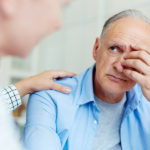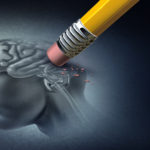By David Blyweiss, M.D., Advanced Natural Wellness
November 29, 2019
“This is the worst headache I’ve ever had in my entire life. I just want to die.”
I have a dear friend who called me one night with a really bad headache. When she got on the phone, she said those magic words we were taught 40 years ago.
Her husband was going to have her lay down with a cold rag.
“Nope,” I said. “Call an ambulance. I’m calling the hospital so they can warm up their CAT scan machine.”
By the time we all arrived at the hospital, the CAT scan was ready and she went right in. The hemorrhagic subarachnoid bleed was there clear as day in her brain. She was into surgery within 45 minutes and made a full recovery due to our quick action.
I’m sharing this story because I want you to understand how easy it would be to ignore the symptoms of a hemorhagic stroke.
And they can happen to anyone at any age…
MD Exposes the Hidden Danger to Your Eyes

When your eyesight starts to fail, it's a real problem. Suddenly you can't go to the grocery store... you can't get to the doctor if you have an emergency... you can't meet your friends for dinner…
Your "regular" doctor doesn't have time to keep up with the latest research. And the same goes for eye doctors. They go to school to learn how to fit you for glasses and contacts, but have no way of preventing the damage and loss of eyesight that threatens your freedom and independence.
Let me show you something that explains a LOT about how your eyes work.
In my FREE Special Report, I'll show you a HUGE, untapped resource for your eyes that safely and naturally restores clear, effortless eyesight.
Click here to get started...
Now recent reports show the overall rates of stroke for people over the age of 65 are in decline. But alarmingly, the rates are rising in younger adults.
That’s right. These life-altering events are striking younger folks more often than ever before. In fact, over a period of just 10 years, stroke rates rose by almost 44% in people between the ages of 25 and 44.
Now, if you fall in this age group you probably think you’re bulletproof. There’s no way you could have a stroke.
Well, that’s exactly what every 20- 30- or 40-something adult who has ever experienced a stroke thought… until it happened to them.
Just like the health insurance company executive I knew here in Florida. He was only 38 years old and suffered from an embolic (blood clot) stroke that left him partially paralyzed with slurred speech. His life was never the same.
So remember, you are never too young to have a stroke.
How Do You Know If It’s Really a Stroke?
It’s hard enough for older folks to imagine having a stroke, let alone if you’re middle-age or younger. So when a stroke does strike, it can be hard to make sense of what’s happening. This often results in a delayed diagnosis.
Unfortunately, any delay in treatment can lead to permanent damage. It can take years of therapy to recover speaking skills and regain control of your body. And about a third of younger adults still have disabilities a full decade after a stroke hits.
That’s the last thing you want to have happen when you still have years of life ahead of you.
Now, there’s an acronym – it’s called FAST – you can use to determine the warning signs of an impending/progressing stroke. This stands for…
- Facial drooping
- Arm weakness
- Speech difficulty
- Time to call 911
If you need help identifying these symptoms, there are some simple ways to check them.
The World's Quickest Solution for Ending Prostate and Urinary Misery
This has recently been revealed to be one of the only real breakthroughs in prostate health.
The seeds of a strange fruit (sometimes called "Chinese Apples") hold powerful phytonutrients that are a revolution in prostate health.
In fact, UCLA and Veterans Administration research have now proved this to be true.
Not only that, but it may be the worlds quickest solution for ending prostate misery.
Simply stated, these phytonutrients represent a huge step beyond beta sitosterol, saw palmetto, and other phytosterols alone.
Simply click HERE if you want to have fast prostate relief...restful, uninterrupted sleep...no more constant "urges to go"...enhanced virility...and optimal prostate support for life.
A smile will quickly show if your face is drooping, because only one side of your mouth will be able to curve upwards. Raising both arms over your head will reveal any arm weakness (in either arm). And speaking a full and coherent sentence can determine any speech difficulties.
For an extremely quick check of symptoms, try raising your arms while sticking out your tongue.
If you experience difficulty with any single one of these tasks, it’s time to call 911 without delay!
What Puts You at Risk for a Stroke?
Some of the most common factors that can lead to a stroke include high blood pressure, obesity and diabetes.
In particular, high blood pressure is a real problem. It plays a role in more than half of all strokes that occur worldwide. And, of course, being overweight and/or having diabetes are both major factors that contribute to high blood pressure.
However, all of these health concerns are highly preventable.
Like I always tell my patients, you – and you alone – have the power to take control of your body and nip these health problems in the bud.
Eating a healthy, rainbow diet, getting plenty of physical activity and managing your stress levels are your first steps. All of these are critically important if you want to maintain a healthy blood flow, halt diabetes and drop excess pounds.
When you’ve got all of that under control, you’ll find you no longer have to worry about your blood pressure. Plus, your risk of a stroke will drop considerably.
But that won’t happen overnight. So while you’re working on getting your body back into a healthy balance, I’d like to suggest a few things you can do to help maintain a healthy blood pressure.
My all-time favorite for healthy blood flow and blood pressure is beetroot juice. Just 250 ml of beetroot juice each day can lower your blood pressure by about 8/4 mmHg (8 points on the top number, 4 points on the bottom number). It also reduces arterial stiffness and thickening of the arteries.
I also recommend getting more garlic in your diet. The effects of this “stinky rose” can reduce plaque in your arteries and improve circulation.
Just two cloves a day will do the job. Or, if you want to keep your breath smelling sweet, try a supplement of 600 mg. aged garlic extract like Kyolic twice a day.
All it might take is a better diet, some regular movement and stress reduction tricks (like not watching the talking news heads on TV) to protect yourself from a life altering or ending stroke.
SOURCES:
Ramirez L, et al. Trends in Acute Ischemic Stroke Hospitalizations in the United States. J Am Heart Assoc. 2016 May; 5(5): e003233.
Early strokes leave many young adults with long-lasting disability. Press Release. American Heart Association Rapid Access Journal Report. Feb 2014
Smajlović D. Strokes in young adults: epidemiology and prevention. Vasc Health Risk Manag. 2015; 11: 157–164.
Webb AJ, et al. Acute blood pressure lowering, vasoprotective, and antiplatelet properties of dietary nitrate via bioconversion to nitrite.Hypertension. 2008 Mar;51(3):784-90.
Kapil V, et al. Dietary nitrate provides sustained blood pressure lowering in hypertensive patients: a randomized, phase 2, double-blind, placebo-controlled study. Hypertension. 2015 Feb;65(2):320-7.
Ashraf R, et al. Effects of Allium sativum (Garlic) on systolic and diastolic blood pressure in patients with essential hypertension. Pak J Pharm Sci. 2013 Sep;26(5):859-63.






